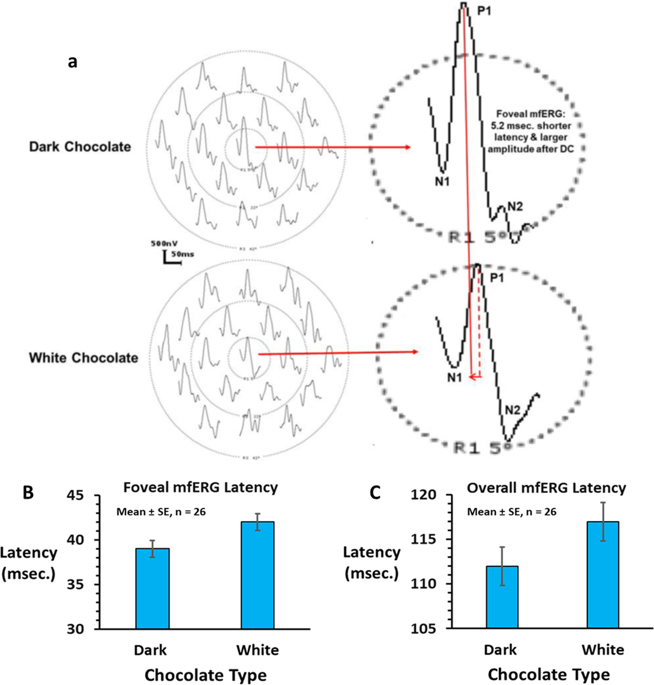Our official English website, www.x-mol.net, welcomes your feedback! (Note: you will need to create a separate account there.)
Effect of dark vs. white chocolate on the multifocal electroretinogram
Eye ( IF 3.9 ) Pub Date : 2020-01-03 , DOI: 10.1038/s41433-019-0757-8 Jeff Rabin 1 , Liana Renteria 1 , Minh Nguyen 1 , Christopher Cha 1 , Fortuna Abebe 1 , Arzoo Wastani 1
Eye ( IF 3.9 ) Pub Date : 2020-01-03 , DOI: 10.1038/s41433-019-0757-8 Jeff Rabin 1 , Liana Renteria 1 , Minh Nguyen 1 , Christopher Cha 1 , Fortuna Abebe 1 , Arzoo Wastani 1
Affiliation

|
Dark chocolate (DC) from flavanol-rich cacao beans improves cardiovascular function, reduces Alzheimer and Parkinson disease symptoms [1–3] and can improve small target contrast sensitivity (CS) [4]. Long-term improvements in diseases are due to antioxidant effects while acute improvements are attributable to increased blood flow via nitric oxide activation [1–3]. Our purpose was to compare acute effects of DC vs. white chocolate (WC) on multifocal electroretinograms (mfERGs) which assesses retinal function from multiple retinal sites [5]. Twenty-six adults (mean age ± SD= 27 ± 3, 17 females, 9 males) with VA ≥ 20/20 participated in our randomized, double-blind crossover study after written informed consent (https://clinicaltrials.gov/ct2/show/ NCT03326934). A DC bar (Trader Joe’s 72% Cacao DC bar: 47 g; cacao, 34 g, total flavanols, 316.3 mg, www. consumerlab.com) was compared with a WC bar (Birthday Cake WC Bar: 58 g; cacao and flavanols, 0 mg.) Diopsys® mfERGs were recorded monocularly from each subject in two separate sessions separated by ≥72 h (mean 5.4 ± 2.5 days). In each session testing commenced 30 min after consumption of either the DC or WC bar with order randomized across subjects and neither experimenters or subjects aware of chocolate type. The mfERG stimulus was 19 hexagons (white 204 cd/m, black 1 cd/m) on an LCD display pseudorandomly reversed for four 1-min periods. Mean retinal mfERGs were recorded from the central 5-degree (R1: fovea), 5–22-degree ring (R2), and 22–42-degree ring (R3). Two-way ANOVA across mfERGs and chocolate type showed no difference between DC and WC N1-P1 amplitudes (F= 0.03, P > 0.84) or P1-N2 amplitudes (F= 1.1, P > 0.20). However, P1 latency was significantly shorter after DC vs. WC (F= 7.3, P < 0.008; Fig. 1). Two-tailed t-tests with Bonferroni correction showed that DC foveal latency (mean [SE], 39 [0.67] ms) was decreased compared with WC (mean [SE], 42 [0.61] ms; mean decrease 3 ms [95% CI, 1–5 ms]; P < 0.02; Fig. 1b). After DC 17/26 (66%) showed shorter foveal latencies vs. only 8/26 after WC (31%; Wilcoxon test, P= 0.02). The sum of average latencies from each ring yielded shorter values for DC (mean [SE], 112 [2.4] ms) vs. WC (mean [SE], 117 [2.9] ms; mean decrease 5 ms [95% CI, 1–9 ms]; P < 0.02; Fig. 1c). Though baseline data were unavailable, WC foveal latency was not different from system norms (P > 0.86) while DC latency was significantly shorter than system norms (P= 0.03). mfERG latency was shorter 30 min after consumption of DC vs. WC. The most significant decrease was from the highly vascularized fovea possibly due to increased choroidal blood flow. Summation of mfERG latencies showed a comparable effect. Study limitations include the small sample size and lack of duration analysis. These results complement improved CS after DC [4] but may underestimate positive DC effects in elderly and diseased eyes (glaucoma, AMD, diabetic retinopathy) which may show enhanced benefits from increased perfusion and antioxidants afforded by DC. Future research targets these populations.
中文翻译:

黑巧克力与白巧克力对多焦视网膜电图的影响
来自富含黄烷醇的可可豆的黑巧克力 (DC) 可改善心血管功能,减少阿尔茨海默病和帕金森病的症状 [1-3],并可提高小目标对比敏感度 (CS) [4]。疾病的长期改善归因于抗氧化作用,而急性改善归因于通过一氧化氮激活增加血流量 [1-3]。我们的目的是比较 DC 与白巧克力 (WC) 对多焦视网膜电图 (mfERG) 的急性影响,该图评估多个视网膜部位的视网膜功能 [5]。26 名 VA ≥ 20/20 的成人(平均年龄 ± SD= 27 ± 3,17 名女性,9 名男性)在书面知情同意后参与了我们的随机、双盲交叉研究 (https://clinicaltrials.gov/ct2 /show/NCT03326934)。DC 棒(Trader Joe's 72% 可可 DC 棒:47 克;可可,34 克,总黄烷醇,316.3 毫克,www. consumerlab.com) 与 WC 条(生日蛋糕 WC 条:58 克;可可和黄烷醇,0 毫克。)在间隔≥72 小时(平均 5.4 ± 2.5天)。在每个会话中,测试在消耗 DC 或 WC 棒后 30 分钟开始,顺序在受试者之间随机分配,并且实验者或受试者都不知道巧克力类型。mfERG 刺激是 LCD 显示器上的 19 个六边形(白色 204 cd/m,黑色 1 cd/m),伪随机反转四个 1 分钟周期。从中央 5 度(R1:中央凹)、5-22 度环(R2)和 22-42 度环(R3)记录平均视网膜 mfERG。mfERG 和巧克力类型的双向 ANOVA 显示 DC 和 WC N1-P1 幅度(F= 0.03,P > 0.84)或 P1-N2 幅度(F= 1.1,P > 0.20)之间没有差异。然而,DC 与 WC 相比,P1 潜伏期明显更短(F = 7.3,P < 0.008;图 1)。带有 Bonferroni 校正的双尾 t 检验表明,与 WC 相比,DC 中心凹延迟(平均 [SE],39 [0.67] ms)减少(平均 [SE],42 [0.61] ms;平均减少 3 ms [95%) CI,1-5 毫秒];P < 0.02;图 1b)。DC 后 17/26 (66%) 显示更短的中央凹潜伏期,而 WC 后仅为 8/26(31%;Wilcoxon 检验,P=0.02)。每个环的平均延迟总和产生了更短的 DC(平均 [SE],112 [2.4] 毫秒)与 WC(平均 [SE],117 [2.9] 毫秒;平均下降 5 毫秒 [95% CI,1])的值–9 ms];P < 0.02;图 1c)。虽然基线数据不可用,但 WC 中心凹潜伏期与系统规范无差异(P > 0.86),而 DC 潜伏期明显短于系统规范(P = 0.03)。与 WC 相比,消耗 DC 后 30 分钟的 mfERG 潜伏期更短。最显着的下降来自高度血管化的中央凹,可能是由于脉络膜血流量增加。mfERG 潜伏期的总和显示出类似的效果。研究局限性包括样本量小和缺乏持续时间分析。这些结果补充了 DC 后改善的 CS [4],但可能低估了 DC 对老年和患病眼睛(青光眼、AMD、糖尿病性视网膜病变)的积极影响,这可能会显示 DC 提供的灌注增加和抗氧化剂的增强益处。未来的研究针对这些人群。这些结果补充了 DC 后改善的 CS [4],但可能低估了 DC 对老年和患病眼睛(青光眼、AMD、糖尿病性视网膜病变)的积极影响,这可能会显示 DC 提供的灌注增加和抗氧化剂的增强益处。未来的研究针对这些人群。这些结果补充了 DC 后改善的 CS [4],但可能低估了 DC 对老年和患病眼睛(青光眼、AMD、糖尿病性视网膜病变)的积极影响,这可能会显示 DC 提供的灌注增加和抗氧化剂的增强益处。未来的研究针对这些人群。
更新日期:2020-01-03
中文翻译:

黑巧克力与白巧克力对多焦视网膜电图的影响
来自富含黄烷醇的可可豆的黑巧克力 (DC) 可改善心血管功能,减少阿尔茨海默病和帕金森病的症状 [1-3],并可提高小目标对比敏感度 (CS) [4]。疾病的长期改善归因于抗氧化作用,而急性改善归因于通过一氧化氮激活增加血流量 [1-3]。我们的目的是比较 DC 与白巧克力 (WC) 对多焦视网膜电图 (mfERG) 的急性影响,该图评估多个视网膜部位的视网膜功能 [5]。26 名 VA ≥ 20/20 的成人(平均年龄 ± SD= 27 ± 3,17 名女性,9 名男性)在书面知情同意后参与了我们的随机、双盲交叉研究 (https://clinicaltrials.gov/ct2 /show/NCT03326934)。DC 棒(Trader Joe's 72% 可可 DC 棒:47 克;可可,34 克,总黄烷醇,316.3 毫克,www. consumerlab.com) 与 WC 条(生日蛋糕 WC 条:58 克;可可和黄烷醇,0 毫克。)在间隔≥72 小时(平均 5.4 ± 2.5天)。在每个会话中,测试在消耗 DC 或 WC 棒后 30 分钟开始,顺序在受试者之间随机分配,并且实验者或受试者都不知道巧克力类型。mfERG 刺激是 LCD 显示器上的 19 个六边形(白色 204 cd/m,黑色 1 cd/m),伪随机反转四个 1 分钟周期。从中央 5 度(R1:中央凹)、5-22 度环(R2)和 22-42 度环(R3)记录平均视网膜 mfERG。mfERG 和巧克力类型的双向 ANOVA 显示 DC 和 WC N1-P1 幅度(F= 0.03,P > 0.84)或 P1-N2 幅度(F= 1.1,P > 0.20)之间没有差异。然而,DC 与 WC 相比,P1 潜伏期明显更短(F = 7.3,P < 0.008;图 1)。带有 Bonferroni 校正的双尾 t 检验表明,与 WC 相比,DC 中心凹延迟(平均 [SE],39 [0.67] ms)减少(平均 [SE],42 [0.61] ms;平均减少 3 ms [95%) CI,1-5 毫秒];P < 0.02;图 1b)。DC 后 17/26 (66%) 显示更短的中央凹潜伏期,而 WC 后仅为 8/26(31%;Wilcoxon 检验,P=0.02)。每个环的平均延迟总和产生了更短的 DC(平均 [SE],112 [2.4] 毫秒)与 WC(平均 [SE],117 [2.9] 毫秒;平均下降 5 毫秒 [95% CI,1])的值–9 ms];P < 0.02;图 1c)。虽然基线数据不可用,但 WC 中心凹潜伏期与系统规范无差异(P > 0.86),而 DC 潜伏期明显短于系统规范(P = 0.03)。与 WC 相比,消耗 DC 后 30 分钟的 mfERG 潜伏期更短。最显着的下降来自高度血管化的中央凹,可能是由于脉络膜血流量增加。mfERG 潜伏期的总和显示出类似的效果。研究局限性包括样本量小和缺乏持续时间分析。这些结果补充了 DC 后改善的 CS [4],但可能低估了 DC 对老年和患病眼睛(青光眼、AMD、糖尿病性视网膜病变)的积极影响,这可能会显示 DC 提供的灌注增加和抗氧化剂的增强益处。未来的研究针对这些人群。这些结果补充了 DC 后改善的 CS [4],但可能低估了 DC 对老年和患病眼睛(青光眼、AMD、糖尿病性视网膜病变)的积极影响,这可能会显示 DC 提供的灌注增加和抗氧化剂的增强益处。未来的研究针对这些人群。这些结果补充了 DC 后改善的 CS [4],但可能低估了 DC 对老年和患病眼睛(青光眼、AMD、糖尿病性视网膜病变)的积极影响,这可能会显示 DC 提供的灌注增加和抗氧化剂的增强益处。未来的研究针对这些人群。


























 京公网安备 11010802027423号
京公网安备 11010802027423号